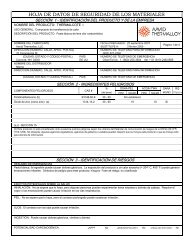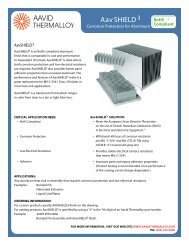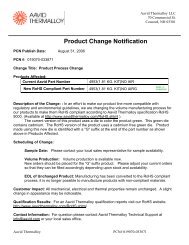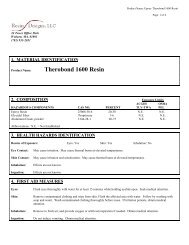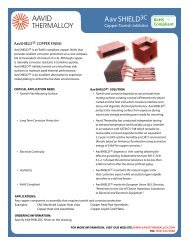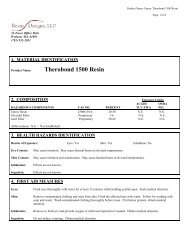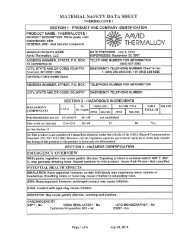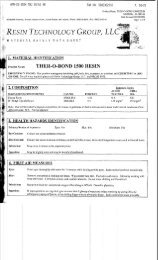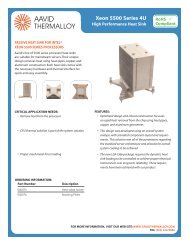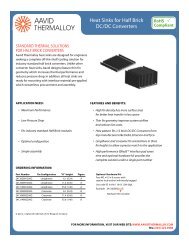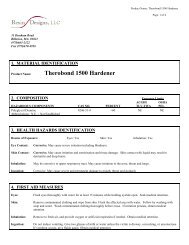Evaluation of Cooling Solutions for Outdoor Electronics - I-revues
Evaluation of Cooling Solutions for Outdoor Electronics - I-revues
Evaluation of Cooling Solutions for Outdoor Electronics - I-revues
Create successful ePaper yourself
Turn your PDF publications into a flip-book with our unique Google optimized e-Paper software.
Budapest, Hungary, 17-19 September 2007<br />
<strong>Evaluation</strong> <strong>of</strong> <strong>Cooling</strong> <strong>Solutions</strong> <strong>for</strong> <strong>Outdoor</strong><br />
<strong>Electronics</strong><br />
Mahendra Wankhede, Vivek Khaire, Dr. Avijit Goswami<br />
Applied Thermal Technologies India<br />
3PrdP Floor, C-Wing, Kapil Towers,<br />
Dr. Ambedkar Road, Pune – 411001<br />
Maharashtra, India<br />
Ph-91-20-66030625<br />
Fax-91-20-66030626<br />
Email: wankhede@appliedthermal.co.in, khaire@appliedthermal.co.in<br />
Abstract-The thermal management <strong>of</strong> an outdoor electronic<br />
enclosure can be quite challenging due to the additional thermal<br />
load from the sun and the requirement <strong>of</strong> having an air-sealed<br />
enclosure. It is essential to consider the effect <strong>of</strong> solar heating<br />
loads in the design process; otherwise, it can shorten the life<br />
expectancy <strong>of</strong> the electronic product or lead to catastrophic<br />
failure. The main objective <strong>of</strong> this work is to analyze and compare<br />
the effectiveness <strong>of</strong> different cooling techniques used <strong>for</strong> outdoor<br />
electronics. Various cooling techniques were compared like<br />
special coats and paints on the outer surface, radiation shield,<br />
double-walled enclosure, fans <strong>for</strong> internal air circulation and airto-air<br />
heat exchangers. A highly simplified, typical outdoor system<br />
was selected <strong>for</strong> this study measuring approximately 300x300x400<br />
mm (WxLxH). Solar radiation was incident on 3 sides <strong>of</strong> the<br />
enclosure. There were 8 equally spaced PCBs inside the enclosure<br />
dissipating 12.5W each uni<strong>for</strong>mly (100 watts total). A<br />
computational fluid dynamics (CFD) model <strong>of</strong> the system was<br />
built and analyzed. This was followed by building a mock-up <strong>of</strong><br />
the system and conducting experiments to validate the CFD<br />
model. It was found that some <strong>of</strong> the simplest cooling techniques<br />
like white oil paint on the outer surface can significantly reduce<br />
the impact <strong>of</strong> solar loads. Adding internal circulation fans can also<br />
be very effective. Using air-to-air heat exchangers was found to be<br />
the most effective solution although it is more complex and costly.<br />
Keywords: Thermal management, electronics cooling, outdoor<br />
cooling, solar loading.<br />
Nomenclature<br />
PCB Printed Circuit Board<br />
R Thermal Resistance, °C/W<br />
T Temperature, °C<br />
∆ Difference<br />
α Solar Absorptivity<br />
ε Infrared Emissivity<br />
Pr<strong>of</strong>. S. D. Mahajan<br />
PIET’s College <strong>of</strong> Engineering, Shivajinagar,<br />
Pune-411005, India<br />
Email: sdm@mech.coep.org.in<br />
Subscripts<br />
amb ambient<br />
conv convection<br />
i inside enclosure<br />
rad radiation<br />
I. INTRODUCTION<br />
<strong>Outdoor</strong> enclosures <strong>for</strong> housing electronic circuit boards<br />
are widely used in variety <strong>of</strong> technologies including<br />
telecommunications, industrial and military applications.<br />
These enclosures protect the equipment against a wide<br />
variety <strong>of</strong> environmental hazards, such as sun, moisture, dust<br />
and debris. As electronic components have become more<br />
powerful and complex, thermal management has become a<br />
critical issue. Power dissipation from the equipment can<br />
build up over time. In addition, solar load further<br />
complicates this problem depending upon the size <strong>of</strong> the<br />
enclosure, surroundings and orientation with respect to the<br />
sun [1]. Ignoring the effect <strong>of</strong> the sun can result in<br />
excessively high internal enclosure temperatures causing<br />
equipment reliability problems or even failure.<br />
A large variety <strong>of</strong> cooling techniques have been proposed<br />
and used to cool outdoor electronic enclosures. These<br />
include conventional techniques, ranging from passive<br />
natural convection to the use <strong>of</strong> commercial air conditioners<br />
or heat pumps and concepts using thermosyphons and PCMs<br />
(Phase Change Materials) [2]. The internal heat is<br />
transferred primarily by convection to the inside surfaces <strong>of</strong><br />
the enclosure, by conduction through the walls <strong>of</strong> the<br />
enclosure and then by convection to the external ambient.<br />
Figure 1 is the simplified representation <strong>of</strong> an outside<br />
enclosure which shows all the thermal resistances that<br />
determine the internal temperature Ti <strong>of</strong> the enclosure [3].<br />
©EDA Publishing/THERMINIC 2007 -1-<br />
ISBN: 978-2-35500-002-7
35mm<br />
Fig 1: Simplified thermal model <strong>of</strong> an <strong>Outdoor</strong> Enclosure<br />
II CFD SIMULATION CONFIGURATIONS<br />
The CFD simulations were done with “ICEPAK”,<br />
specialised s<strong>of</strong>tware <strong>for</strong> electronics cooling. Total 12 types <strong>of</strong><br />
cooling configurations were simulated, out <strong>of</strong> them 9<br />
configurations were created by making combinations <strong>of</strong> three<br />
types <strong>of</strong> commonly used airflow management options and three<br />
types <strong>of</strong> enclosure surface coatings. Besides these three special<br />
configurations were selected which included solar radiation<br />
shield, double wall enclosure and a heat exchanger; using a<br />
typical aluminium enclosure measuring 300x300x400 mm<br />
(WxLxH). There were 8 printed circuit boards (PCBs) inside,<br />
30mm<br />
35mm<br />
PCB<br />
Enclosure<br />
Fig. 2: Icepak Model <strong>of</strong> Enclosure with PCB assembly<br />
each dissipating 12.5W uni<strong>for</strong>mly bringing the total internal<br />
power dissipation to 100W. The distance between each PCB<br />
was 30mm. The PCB measured 240x180mm and 3mm thick.<br />
There was a gap <strong>of</strong> 35mm between the extreme PCBs and the<br />
side faces <strong>of</strong> the enclosure as shown in fig. 2. Three types <strong>of</strong><br />
enclosures were selected – first is completely sealed; second<br />
sealed with internal circulation fans and the third having vents<br />
that allow air exchange with the outside. Three varieties <strong>of</strong><br />
outside coating were examined including white, black and no<br />
coating (plain aluminium finish). These coatings were selected<br />
based on their radiation characteristics i.e. solar absorptivity<br />
(α) and radiation emissivity (ε). White oil coating had a low<br />
value <strong>of</strong> α (0.25) and a high value <strong>of</strong> ε (0.91) making it very<br />
Budapest, Hungary, 17-19 September 2007<br />
favourable <strong>for</strong> cooling under solar heat loads. Black coating<br />
had a high value <strong>of</strong> α (0.88) and a high value <strong>for</strong> ε (0.88) while<br />
the plain aluminium finish had low values <strong>for</strong> α and ε (0.08,<br />
0.09) [4]. In order to minimize the effect <strong>of</strong> solar loads, various<br />
options were analyzed including having a radiation shield,<br />
having a double-walled enclosure with air circulation (fig. 3)<br />
and a sophisticated air-to-air heat exchanger (fig. 4).<br />
The sealed enclosure with internal fans case was modelled as<br />
two fans placed above the PCB assembly and oriented in<br />
suction mode pulling the air through the PCB assembly slots.<br />
The fan selected was 80x80x20mm and had a maximum flow<br />
capacity 48.20 CFM (cubic feet per minute) and a maximum<br />
pressure capacity <strong>of</strong> 6.22mm <strong>of</strong> H2O. The enclosure with<br />
louvered vents case was modelled as two opposite enclosure<br />
walls perpendicular to the PCBs having cut-outs at the bottom<br />
and top side. The double walled enclosure had an air gap <strong>of</strong><br />
20mm between the inner and outer walls. A fan was placed at<br />
the top <strong>of</strong> the outer wall sucking the air between the inner and<br />
outer walls through four openings at the bottom <strong>of</strong> each outer<br />
side wall (fig. 3). For this case the fan selected was a<br />
120x120x25mm having a maximum flow capacity 113.11<br />
CFM and a maximum pressure capacity <strong>of</strong> 10.92mm <strong>of</strong> H2O.<br />
For the case with radiation shield, an umbrella was used to<br />
shield the sunlight. In the simulation model, this was modelled<br />
as zero solar loads on the enclosure and no radiation heat<br />
transfer from the top wall. The heat exchanger system<br />
consisted <strong>of</strong> two parallel heat pipes with condenser ends<br />
coming out <strong>of</strong> the enclosure (fig. 4). Fins were attached to the<br />
heat pipes inside the enclosure as well as outside the enclosure.<br />
Fans were used to blow air through both sets <strong>of</strong> fins. Fans<br />
selected <strong>for</strong> this case were 80x80x20mm and had a maximum<br />
flow capacity 48.20 CFM and a maximum pressure capacity <strong>of</strong><br />
6.22mm <strong>of</strong> HB2BO. Fig. 4 also shows a schematic <strong>of</strong> the air<br />
circulation pattern and the heat flow from inside the enclosure<br />
to the outside.<br />
The following represents a summary <strong>of</strong> all the configurations<br />
analyzed and the abbreviations used.<br />
NC_SL : Sealed enclosure without coating,<br />
NC_LV : Louvered enclosure without coating,<br />
NC_WF : Sealed enclosure without coating and with<br />
internal fans,<br />
BC_SL : Sealed enclosure with black coating,<br />
BC_LV : Louvered enclosure with black coating,<br />
BC_WF : Sealed enclosure with black coating and<br />
with internal fans,<br />
WC_SL : Sealed enclosure with white coating,<br />
WC_LV : Louvered enclosure with white coating<br />
WC_WF: Sealed enclosure with white coating and with<br />
internal fans,<br />
WC_SL_SHLD: White coated sealed enclosure with<br />
radiation shield,<br />
WC_SL_DW: White coated sealed double wall enclosure,<br />
WC_SL_HX: White coated sealed enclosure with a heat<br />
exchanger.<br />
©EDA Publishing/THERMINIC 2007 -2-<br />
ISBN: 978-2-35500-002-7
Outside<br />
Fins<br />
PCB<br />
Bottom Grill on the<br />
outer wall to suck air<br />
Plate<br />
with<br />
inside<br />
fans<br />
Heat pipe carrying heat<br />
Top Fan on<br />
the outer wall<br />
Fig. 3: Schematic <strong>of</strong> Double wall enclosure<br />
Inside Fins<br />
Outer Wall<br />
Inner Wall<br />
PCB<br />
Air<br />
Circulation<br />
Inside the<br />
enclosure<br />
Fig. 4: Heat Transfer mechanism inside enclosure with heat<br />
exchanger system<br />
Outside Fan<br />
Simulations were run with solar heat load as well as<br />
without. For the cases with solar load the maximum load is<br />
assumed to be 600 W/m 2 <strong>for</strong> Pune city (India) in the month<br />
<strong>of</strong> March [5] which is one <strong>of</strong> the hottest months <strong>of</strong> the year.<br />
The sun’s rays were assumed to be incident on three adjacent<br />
surfaces – the top surface and two sides. This works out to a<br />
total solar load <strong>of</strong> anywhere between 0 and 200W depending<br />
upon the solar absorptivity <strong>of</strong> the outer surface. This shows<br />
that the solar load can be <strong>of</strong> the same magnitude as the<br />
internal thermal load.<br />
Budapest, Hungary, 17-19 September 2007<br />
III CFD SIMULATION RESULTS WITHOUT SOLAR LOAD<br />
Initially, a set <strong>of</strong> simulation runs were carried out without<br />
any solar heat loads. The following graphs depict the<br />
simulation ∆T values <strong>for</strong> middle PCB surface and the air inside<br />
the enclosure (fig. 5a and 5b) without solar load.<br />
The air temperature inside the enclosure was measured just<br />
above the PCB assembly. It can be seen that by just having an<br />
internal circulation fan the internal temperatures can be<br />
significantly reduced. It is also well below the configuration<br />
having vents. In fact, it can be seen that vents have a relatively<br />
small impact on the temperatures. Having a black or a white<br />
coated surface can also be very effective. The case having a<br />
white coated enclosure with heat exchanger had the lowest ∆T<br />
values. In this case, a significant amount <strong>of</strong> heat is dissipated to<br />
the outside through the heat exchanger. In the cases <strong>of</strong> doublewalled<br />
enclosure and radiation shield there isn’t any<br />
improvement since there was no solar load.<br />
Temperature rise above Ambient <strong>for</strong> air inside the Enclosure<br />
(Simulation)<br />
©EDA Publishing/THERMINIC 2007 -3-<br />
ISBN: 978-2-35500-002-7<br />
Temperature Difference C<br />
O<br />
Temperature Difference C<br />
O<br />
90<br />
80<br />
70<br />
60<br />
50<br />
40<br />
30<br />
20<br />
10<br />
0<br />
90<br />
80<br />
70<br />
60<br />
50<br />
40<br />
30<br />
20<br />
10<br />
0<br />
Temperature rise above Ambient <strong>for</strong> Middle PCB (Simulation)<br />
NC_SL<br />
NC_LV<br />
NC_WF<br />
NC_SL<br />
NC_LV<br />
NC_WF<br />
BC_SL<br />
BC_LV<br />
BC_WF<br />
BC_SL<br />
BC_LV<br />
BC_WF<br />
Cases<br />
Cases<br />
WC_SL<br />
WC_LV<br />
WC_WF<br />
WC_SL<br />
WC_LV<br />
WC_WF<br />
WC_SL_SHLD<br />
WC_SL_DW<br />
WC_SL_HX<br />
Fig. 5a: Simulation values <strong>of</strong> ∆T without solar loading <strong>for</strong><br />
middle PCB<br />
WC_SL_SHLD<br />
WC_SL_DW<br />
WC_SL_HX<br />
Fig. 5b: Simulation values <strong>of</strong> ∆T without solar loading <strong>for</strong> air<br />
inside the enclosure
Budapest, Hungary, 17-19 September 2007<br />
IV CFD SIMULATION RESULTS WITH SOLAR LOADING tested with three types <strong>of</strong> coats; white coat, black and a plain<br />
For cases with solar heat load the ∆T values <strong>for</strong> middle<br />
aluminium finish (fig. 7). Experiments were conducted<br />
PCB are almost 20% higher <strong>for</strong> sealed black enclosure (fig. indoor as well as outdoor conditions. Fig. 8 represents<br />
6a and 6b), showing that solar loading can be substantial <strong>for</strong><br />
schematic <strong>of</strong> the enclosure set-up and the temperature<br />
outdoor enclosures. Similar trends were observed compared<br />
measurement locations.<br />
to the cases without solar loading. The results again show<br />
that by just having an internal circulation fan can<br />
significantly reduce the internal temperatures. Also, a black<br />
Temperature Difference C<br />
O<br />
90<br />
80<br />
70<br />
60<br />
50<br />
40<br />
30<br />
20<br />
10<br />
0<br />
Temperature rise above Ambient <strong>for</strong> Middle PCB with Solar<br />
loading (Simualtion)<br />
NC_SL<br />
NC_LV<br />
NC_WF<br />
BC_SL<br />
BC_LV<br />
BC_WF<br />
Cases<br />
WC_SL<br />
WC_LV<br />
WC_WF<br />
WC_SL_SHLD<br />
WC_SL_DW<br />
WC_SL_HX<br />
Fig. 6a: Simulation values <strong>of</strong> ∆T with solar loading <strong>for</strong> middle<br />
PCB<br />
or preferably white coated surface can be very effective <strong>for</strong><br />
cooling compared to a plain aluminium finish. This is<br />
because the white coating has a very favourable combination<br />
<strong>for</strong> low solar absorptivity and high radiation emissivity. The<br />
temperatures were the least in the case <strong>of</strong> the air-to-air heat<br />
exchanger. It was found that in this case nearly 60 W (40 %)<br />
were dissipated through the heat exchanger.<br />
V EXPERIMENTAL VALIDATION<br />
To validate the CFD results a mock-up <strong>of</strong> the system<br />
was built and tested. Three types <strong>of</strong> enclosures were built<br />
similar to the CFD modelling configurations; perfectly<br />
sealed enclosure, one with louvered vents and a sealed<br />
enclosure with internal fans. Each configuration was further<br />
Temperature Difference C<br />
O<br />
90<br />
80<br />
70<br />
60<br />
50<br />
40<br />
30<br />
20<br />
10<br />
0<br />
Temperature rise above Ambient <strong>for</strong> air inside the Enclosure<br />
with Solar loading (Simulation)<br />
NC_SL<br />
NC_LV<br />
NC_WF<br />
BC_SL<br />
BC_LV<br />
BC_WF<br />
Cases<br />
WC_SL<br />
WC_LV<br />
WC_WF<br />
WC_SL_SHLD<br />
WC_SL_DW<br />
WC_SL_HX<br />
Fig. 6b: Simulation values <strong>of</strong> ∆T with solar loading <strong>for</strong> air inside the<br />
enclosure<br />
Black Enclosure Aluminium Enclosure White Enclosure<br />
Fig. 7: Enclosures with three different surfaces<br />
The enclosures were constructed using 1mm thick<br />
aluminium sheets assembled together using nuts and bolts. The<br />
printed circuit boards (PCBs) were made using resistor coils<br />
sandwiched between two commercially available copper clad<br />
boards (fig. 9). The PCB assembly was placed inside the<br />
enclosure suspended from two rods (fig. 10). The<br />
thermocouples and DC source wiring was taken out through an<br />
opening created on the top side <strong>of</strong> the enclosure. Each PCB<br />
resistors were connected as shown in fig. 11. The power<br />
Thermocouple Points 1, 2, 3, 4 & 5<br />
©EDA Publishing/THERMINIC 2007 -4-<br />
ISBN: 978-2-35500-002-7<br />
1<br />
1<br />
4<br />
2<br />
4<br />
5<br />
Fig. 8: Schematic <strong>of</strong> Enclosure Set-up and temperature<br />
measurement locations.<br />
8<br />
3<br />
Enclosure<br />
PCBs<br />
1, 4 & 8
Resistance Copper Clad PCB<br />
coil<br />
Fig. 9: Resistance coils<br />
sandwiched between PCBs<br />
supplied to the enclosure was 100 watts through an external<br />
DC power supply and was maintained constant <strong>for</strong> all the<br />
cases. To monitor the temperatures a data acquisition system<br />
R1<br />
R2<br />
R3<br />
(DAS) was used. Temperatures were measured on the surfaces<br />
<strong>of</strong> the middle and extreme PCBs and also the enclosure air<br />
temperatures were measured at the bottom and at the top <strong>of</strong> the<br />
PCB assembly using T-type thermocouples as shown in fig. 8.<br />
For the test case with internal fans, the fans were placed above<br />
the PCBs and oriented in the suction mode pulling air through<br />
the PCB slots (fig. 12). Fig. 13 shows white coated louvered<br />
enclosure with louvered cut-outs at the top and bottom sides.<br />
To ensure the system to be air tight all the side gaps were<br />
Fans<br />
Louvered cut outs at the top<br />
Fig. 12: Enclosure with fans (Top and one<br />
side panel removed)<br />
R4<br />
R5<br />
R6<br />
R7<br />
R8<br />
R9<br />
Rods<br />
PCBs suspended from the rods<br />
R10<br />
Fig. 10: Arrangement <strong>for</strong><br />
supporting PCB assembly<br />
PCB PCB PCB PCB PCB PCB PCB PCB<br />
Fig.11: Circuit diagram showing the layout <strong>of</strong> resistor heaters on the<br />
PCBs.<br />
R11<br />
R12<br />
R13<br />
R14<br />
R15<br />
R16<br />
Fig. 13: Louvered Enclosure<br />
Budapest, Hungary, 17-19 September 2007<br />
sealed using tapes. After the system was powered using the DC<br />
2<br />
source, it was found that there were significant PR IP losses in the<br />
wiring from DC source to the PCB assembly. To ensure 100<br />
watts heat dissipation in the enclosure, the input power from<br />
the DC source was increased in such a way as to compensate<br />
2<br />
<strong>for</strong> the IP PR losses. It was also found that the individual PCB<br />
resistances differed slightly. There<strong>for</strong>e, the PCBs that were<br />
Comparison between Simulation and Experimental value <strong>for</strong><br />
Temperature rise above Ambient <strong>of</strong> Middle PCB <strong>for</strong> Black<br />
coated Sealed Enclosure with Solar loading<br />
Fig. 15b: Comparison <strong>of</strong> Simulation and Experimental ∆T value <strong>for</strong><br />
middle PCB with solar loading <strong>for</strong> black coated sealed enclosure<br />
©EDA Publishing/THERMINIC 2007 -5-<br />
ISBN: 978-2-35500-002-7<br />
Temperature Difference C<br />
O<br />
Temperature Difference C<br />
O<br />
90<br />
80<br />
70<br />
60<br />
50<br />
40<br />
30<br />
20<br />
10<br />
90<br />
80<br />
70<br />
60<br />
50<br />
40<br />
30<br />
20<br />
10<br />
0<br />
0<br />
Fig. 14: Experimental set-up <strong>for</strong> test with solar loading<br />
Comparison between Experimental and Simualtion value <strong>of</strong><br />
Temperature rise above Ambient <strong>for</strong> Middel PCB<br />
NC_SL<br />
NC_LV<br />
NC_WF<br />
BC_SL<br />
BC_LV<br />
BC_WF<br />
1<br />
Middle PCB<br />
Experimental Simulation<br />
WC_SL<br />
WC_LV<br />
WC_WF<br />
Cases<br />
Fig. 15a: Comparison <strong>of</strong> Simulation and Experimental ∆T value <strong>for</strong><br />
middle PCB<br />
Experimental Simulation
chosen <strong>for</strong> measurement were only those which dissipated<br />
close to 12.5 watts. For the test case with solar loading the<br />
black enclosure was tested outside in the sun. Cardboards were<br />
used around the enclosure to block <strong>of</strong>f the wind but without<br />
blocking the sunlight falling over the enclosure (fig. 14).<br />
Temperature readings were recorded after the system reached a<br />
steady state which took around couple <strong>of</strong> hours.<br />
VI COMPARISON BETWEEN CFD AND TEST RESULTS<br />
From fig. 15a it is seen that the tested ∆T values are quite close<br />
to the CFD results <strong>for</strong> all the tested cases. The percentage<br />
difference between the CFD simulation and test results is<br />
defined as;<br />
( Expt.<br />
value − simulation.<br />
value)<br />
× 100<br />
% ∆ =<br />
Expt.<br />
value<br />
It is observed that the difference is within ±10% (fig. 15a) <strong>for</strong><br />
all the cases with fans. In the other cases the difference is<br />
around ±15%. Since in these non-fan cases radiation heat<br />
transfer plays a more significant role as compared to the cases<br />
with internal fans, the higher differences are probably due to<br />
the assumed values <strong>of</strong> radiation emissivitiy in the simulations.<br />
CONCLUSION<br />
It was found from this study that the effect <strong>of</strong> solar heat load on<br />
an outdoor system can be quite significant and can increase the<br />
internal air temperature by 20%. Different cooling approaches<br />
<strong>for</strong> outdoor electronic enclosures were analyzed and compared.<br />
The results indicate the relative effectiveness <strong>of</strong> these different<br />
cooling solutions. Relative to the sealed enclosure without any<br />
coating it was found that black or preferably a white coating on<br />
the outside enclosure wall is a very simple and effective<br />
cooling solution and can reduce internal temperatures by<br />
around 25%. It was also found that having vents did not reduce<br />
the temperatures as significantly as having internal circulation<br />
fans. In fact, there is around 50-55% reduction in the ∆T due to<br />
the internal fans compared to a sealed enclosure with no fans.<br />
Having a radiation shield and a double-walled enclosure with<br />
air circulation provided relatively modest improvements <strong>of</strong><br />
around 25%. The most dramatic improvement was seen in case<br />
<strong>of</strong> the air-to-air heat exchanger <strong>of</strong> almost 75%.<br />
ACKNOWLEDGMENT<br />
Authors <strong>of</strong> the paper are thankful to Dr. Sukhvinder S. Kang<br />
<strong>for</strong> his valuable review <strong>of</strong> the paper and suggestion during the<br />
work.<br />
REFERENCES<br />
[1] Thomas G. Volk, “Thermal Requirements <strong>for</strong> Electronic Equipment<br />
Cabinets Exposed to <strong>Outdoor</strong> Environments”, Reliance Comm/Tec<br />
Franklin Park, IL 60131 USA, 1990<br />
[2] Maurice J. Marongiu, “Issues in Thermal Management <strong>of</strong> <strong>Outdoor</strong><br />
Telecommunications Cabinets/Enclosures”, MJM Engineering Co.,<br />
Naperville, IL 60563,<br />
[3] Renee Estes, “Thermal Management <strong>of</strong> Telecommunication Cabinets”,<br />
Budapest, Hungary, 17-19 September 2007<br />
<strong>Electronics</strong> <strong>Cooling</strong>, September 1997 vol. 3 No. 3<br />
[4] Thermal Finishes Data; http://www.tak2000.com/data/finish.htm<br />
[5] University <strong>of</strong> Massachusetts Lowell, Solar Energy Database;<br />
http://energy.caeds.eng.uml.edu/solbase.html<br />
[6] J. R. McKay, “Coping with high heat loads in Electronic Telephone<br />
Systems <strong>of</strong> the Future”, Bell Communications Research, Morristown, NJ,<br />
USA, 1998<br />
[7] M. R. Cosley and et al, “Thermal Development <strong>of</strong> Modular <strong>Outdoor</strong><br />
Cabinets”, Reliable Electric Division, Reliance Comm/Tec Franklin Park,<br />
IL, 60131, USA, 1995<br />
[8] M. J. Marongiu and et al, “Design and Development <strong>of</strong> a Passively<br />
cooled Remote <strong>Outdoor</strong> Cabinet”, MJM Engineering Co., Naperville, IL,<br />
USA, 1998<br />
[9] K. Nevelsteen and et al, “Thermal Modelling and Experimental<br />
<strong>Evaluation</strong> <strong>of</strong> <strong>Outdoor</strong> Cabinets”, Thermal Challenges in Next<br />
Generation Electronic Systems, Joshi & Garimella (eds) Millpress,<br />
Rotterdam, 2002<br />
[10] Mark Hendrix, “<strong>Cooling</strong> Design <strong>of</strong> a Sealed Optical Network Unit<br />
(ONU) Enclosure”, Fujitsu Network Communications, Richardson, TX,<br />
57082<br />
[11] J. P. Holman, “Heat Transfer”, Mc-Graw Hill Publication, 1990<br />
©EDA Publishing/THERMINIC 2007 -6-<br />
ISBN: 978-2-35500-002-7



